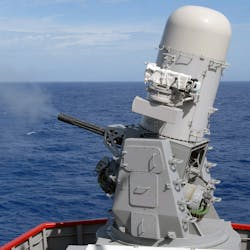Navy asks Raytheon to upgrade radar-guided machine guns for ship defense aboard South Korea surface warships
WASHINGTON – Shipboard weapons experts at Raytheon Technologies Corp. will upgrade computer-controlled and radar-guided Gatling guns that defend surface warships of the Republic of Korea from anti-ship missiles, manned aircraft, and drones under terms of a $49 million order announced Thursday.
Officials of the Naval Sea Systems Command in Washington are asking the Raytheon Missiles & Defense segment in Tucson, Ariz., for four MK-15 Close-In Weapon Systems (CIWS) Block 0 to Block 1B Baseline 2 upgrade and conversion and related equipment for Korean warships under the foreign military sales program.
CIWS, often pronounced "sea-wiz," is a fast-reaction radar-guided terminal shipboard air defense against low- and high-flying, high-speed maneuvering anti-ship missile threats that have penetrated all other defenses. These high-volume machine guns, deployed since the early 1980s, designed to throw out a curtain of bullets that shred incoming missiles and aircraft.
These ship-defense systems are for the Korean Sejong the Great-class guided-missile destroyer, and for Korean destroyers in development under the Korean Destroyer Next Generation project.
At sea, the CIWS is designed to defeat anti-ship missiles and other close-in threats that have pierced other lines of defense. It also has a land use as a counter-rocket, artillery, and mortar system that detects and destroys incoming rounds.
A self-contained package, the CIWS shipboard weapons automatically handle search, detection, threat evaluation, tracking, engagement, and kill assessment. The Block 1B version of the system adds control stations that enable operators to track and identify targets visually before engagement.
The 1B variant's configuration augments the CIWS anti-air warfare capability by adding a forward-looking infrared sensor for use against helicopters and high-speed surface craft at sea. The CIWS is installed on all U.S. Navy surface combatant ship classes and on those of 24 allied nations.
On this contract Raytheon will do the work in Louisville, Ky.; Anaheim and Palo Alto, Calif.; Williston, Vt.; Tucson, Phoenix, and Tempe, Ariz.; Andover, Mass.; Mason and Dayton, Ohio; Melbourne, Fla.; Joplin, Mo.; Hauppauge, N.Y.; Grand Rapids, Mich.; and Norcross, Ga., and should be finished by May 2025.
For more information contact Raytheon Missiles & Defense online at www.raytheonmissilesanddefense.com, or Naval Sea Systems Command at www.navsea.navy.mil.
About the Author
John Keller
Editor-in-Chief
John Keller is the Editor-in-Chief, Military & Aerospace Electronics Magazine--provides extensive coverage and analysis of enabling electronics and optoelectronic technologies in military, space and commercial aviation applications. John has been a member of the Military & Aerospace Electronics staff since 1989 and chief editor since 1995.
